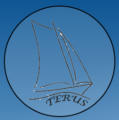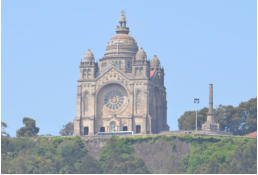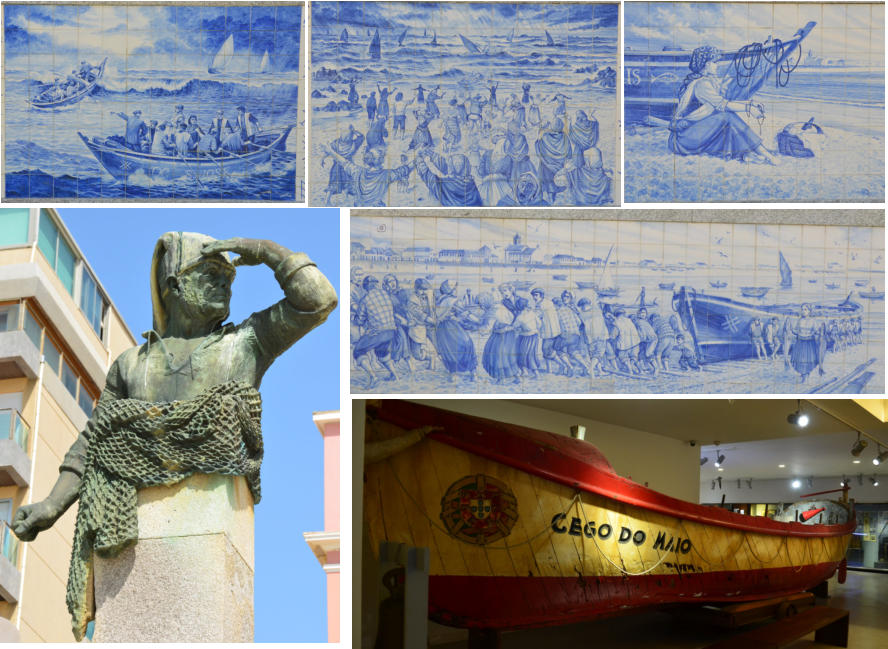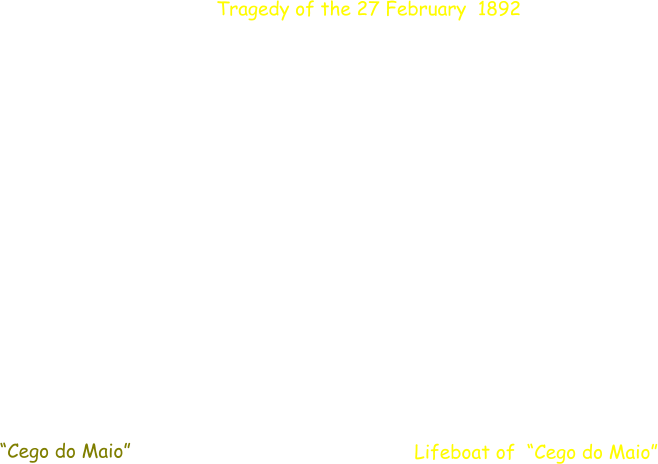












Our Journey: 2015
Viana do Castelo - Povoa de Warzim: ( 8-14 April 2015)
Viana do Castelo: (8 -11 April 2015)


Our first stop in Portugal was in the marina of Viana do Castelo. The harbor is located inland on the river Lima. We did not need to go far as our passage is blocked by the Eiffel bridge
on the river Lima. We did not need to go far as our passage is blocked by the Eiffel bridge that crosses the river. Today this bridge is used by cars and trains. High on the hill is the St.
that crosses the river. Today this bridge is used by cars and trains. High on the hill is the St. Luzia cathedral which dominates the city. The cathedral was built in around 1950 and has
Luzia cathedral which dominates the city. The cathedral was built in around 1950 and has little interest except that the view from there is very good. Behind the cathedral you can find
little interest except that the view from there is very good. Behind the cathedral you can find the remains of a Celtic Village dating from the stone-age. Viano do Castelo is really different
the remains of a Celtic Village dating from the stone-age. Viano do Castelo is really different from Spanish towns with a different architecture and houses decorated with beautiful
from Spanish towns with a different architecture and houses decorated with beautiful ceramic tiles called azulejos.
ceramic tiles called azulejos.
 On the river we also could see a lot of people casting their nets to catch a popular fish, the
On the river we also could see a lot of people casting their nets to catch a popular fish, the lamprey. This fish looks like an enormous bloodsucker that migrate in the spring up the rivers
lamprey. This fish looks like an enormous bloodsucker that migrate in the spring up the rivers to lay its eggs. This fish is a delicacy on the Atlantic coast all the way down from the south of
to lay its eggs. This fish is a delicacy on the Atlantic coast all the way down from the south of  France into Spain and Portugal. The city of Povoa de Warzim is divided in two. On the south
France into Spain and Portugal. The city of Povoa de Warzim is divided in two. On the south side located in front of the harbor is the old city with houses that rarely have more than 2
side located in front of the harbor is the old city with houses that rarely have more than 2 floors. On the north side you have the Balnearic city with apartments blocks of 6 to 8 floors.
floors. On the north side you have the Balnearic city with apartments blocks of 6 to 8 floors. This part of the city had little interest for us. Between the 2 sides of the city you have the
This part of the city had little interest for us. Between the 2 sides of the city you have the Casino to clearly indicate the 2 sides of the city.
Casino to clearly indicate the 2 sides of the city. Povoa de Warzim: (11-14 April 2015)
Povoa de Warzim has always been a fishing city as witnessed by the numerous blue ceramics
Povoa de Warzim: (11-14 April 2015)
Povoa de Warzim has always been a fishing city as witnessed by the numerous blue ceramics tiles (Azulejos) that depicts the life of the fishing community. Amongst them we found
tiles (Azulejos) that depicts the life of the fishing community. Amongst them we found records of two disasters that affected the community: the storm of 27 February 1892 in
records of two disasters that affected the community: the storm of 27 February 1892 in which 105 fisherman lost their lives and the rescuing of the passengers of the English ship
which 105 fisherman lost their lives and the rescuing of the passengers of the English ship  “Le Veronese” that grounded nearby on 16 January 1913. Thanks to the efforts of he local
“Le Veronese” that grounded nearby on 16 January 1913. Thanks to the efforts of he local  people only 27 were listed as dead or missing out of the 234 people on board. A video showing
people only 27 were listed as dead or missing out of the 234 people on board. A video showing the efforts to save the passengers can be seen on the folowing link. The city also honours in
the efforts to save the passengers can be seen on the folowing link. The city also honours in different places, a local hero, Mr “Cego do Maio”. He lived from 1817 till 1884 and saved, in
different places, a local hero, Mr “Cego do Maio”. He lived from 1817 till 1884 and saved, in often difficult situations, numerous fishermen. He was decorated by the king Don Luis himself
often difficult situations, numerous fishermen. He was decorated by the king Don Luis himself with the highest awards the country could bestow on him for his contributions.
with the highest awards the country could bestow on him for his contributions. 

 on the river Lima. We did not need to go far as our passage is blocked by the Eiffel bridge
on the river Lima. We did not need to go far as our passage is blocked by the Eiffel bridge that crosses the river. Today this bridge is used by cars and trains. High on the hill is the St.
that crosses the river. Today this bridge is used by cars and trains. High on the hill is the St. Luzia cathedral which dominates the city. The cathedral was built in around 1950 and has
Luzia cathedral which dominates the city. The cathedral was built in around 1950 and has little interest except that the view from there is very good. Behind the cathedral you can find
little interest except that the view from there is very good. Behind the cathedral you can find the remains of a Celtic Village dating from the stone-age. Viano do Castelo is really different
the remains of a Celtic Village dating from the stone-age. Viano do Castelo is really different from Spanish towns with a different architecture and houses decorated with beautiful
from Spanish towns with a different architecture and houses decorated with beautiful ceramic tiles called azulejos.
ceramic tiles called azulejos.
 On the river we also could see a lot of people casting their nets to catch a popular fish, the
On the river we also could see a lot of people casting their nets to catch a popular fish, the lamprey. This fish looks like an enormous bloodsucker that migrate in the spring up the rivers
lamprey. This fish looks like an enormous bloodsucker that migrate in the spring up the rivers to lay its eggs. This fish is a delicacy on the Atlantic coast all the way down from the south of
to lay its eggs. This fish is a delicacy on the Atlantic coast all the way down from the south of  France into Spain and Portugal. The city of Povoa de Warzim is divided in two. On the south
France into Spain and Portugal. The city of Povoa de Warzim is divided in two. On the south side located in front of the harbor is the old city with houses that rarely have more than 2
side located in front of the harbor is the old city with houses that rarely have more than 2 floors. On the north side you have the Balnearic city with apartments blocks of 6 to 8 floors.
floors. On the north side you have the Balnearic city with apartments blocks of 6 to 8 floors. This part of the city had little interest for us. Between the 2 sides of the city you have the
This part of the city had little interest for us. Between the 2 sides of the city you have the Casino to clearly indicate the 2 sides of the city.
Casino to clearly indicate the 2 sides of the city. Povoa de Warzim: (11-14 April 2015)
Povoa de Warzim has always been a fishing city as witnessed by the numerous blue ceramics
Povoa de Warzim: (11-14 April 2015)
Povoa de Warzim has always been a fishing city as witnessed by the numerous blue ceramics tiles (Azulejos) that depicts the life of the fishing community. Amongst them we found
tiles (Azulejos) that depicts the life of the fishing community. Amongst them we found records of two disasters that affected the community: the storm of 27 February 1892 in
records of two disasters that affected the community: the storm of 27 February 1892 in which 105 fisherman lost their lives and the rescuing of the passengers of the English ship
which 105 fisherman lost their lives and the rescuing of the passengers of the English ship  “Le Veronese” that grounded nearby on 16 January 1913. Thanks to the efforts of he local
“Le Veronese” that grounded nearby on 16 January 1913. Thanks to the efforts of he local  people only 27 were listed as dead or missing out of the 234 people on board. A video showing
people only 27 were listed as dead or missing out of the 234 people on board. A video showing the efforts to save the passengers can be seen on the folowing link. The city also honours in
the efforts to save the passengers can be seen on the folowing link. The city also honours in different places, a local hero, Mr “Cego do Maio”. He lived from 1817 till 1884 and saved, in
different places, a local hero, Mr “Cego do Maio”. He lived from 1817 till 1884 and saved, in often difficult situations, numerous fishermen. He was decorated by the king Don Luis himself
often difficult situations, numerous fishermen. He was decorated by the king Don Luis himself with the highest awards the country could bestow on him for his contributions.
with the highest awards the country could bestow on him for his contributions. 






























